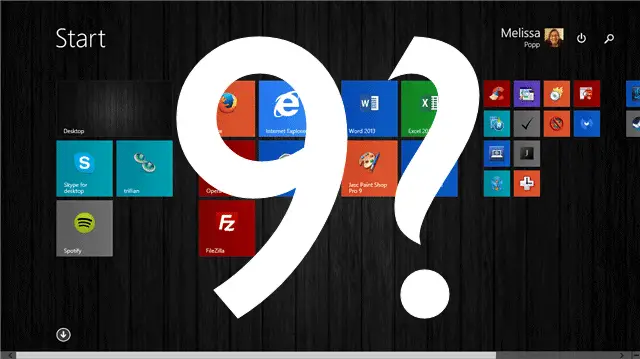
Every other day, you’re hearing some report about Windows 9 this or Windows 9 that. While our most reliable Microsoft sources are saying an official announcement or reveal is coming, we’re just not sure when. We will get a pretty good idea about the release date when the folks at Microsoft reveal the initial version.
While most experts are pegging this announcement to come on September 30, 2014, the real question shouldn’t be when will the reveal be, it should be: What will the Windows 9 reveal be?
Let’s face it: Windows 8, and the 8.1 update, is a flop in consumer’s eyes. While the adoption rates are higher, with 7 and XP dwindling away, consumers – and even Microsoft fan boys – haven’t taken to 8 with the gusto the company hoped for its latest flagship product.
Recommended Reading: Here’s How Microsoft Plans to Fix Windows 9 After the Windows 8 Debacle
What We (Really Don’t) Know
Windows 9, as far as the industry can tell, isn’t a new version of Windows 7, 8 or 8.1. It’s some hybrid or combination of the three, taking some of the better features of one, mixing them with another, and coming up with a more familiar OS for consumers who felt 8 and 8.1 lacked the functionality and control they were used to in 7.
Is Microsoft rolling us back to Windows 7? Certainly not!
Microsoft’s goal with Windows 8 was simple: To start the consumer journey into a fully integrated unified OS between its major products. This included Windows 8, Xbox One and Windows Phone. In theory, this was a great strategy, and something Apple’s seen success with between its OS and iPhone products. However, what Microsoft released, was so far ahead of the curve to many consumers, they just couldn’t get over how different Windows 8 really was compared to the familiar desktop of Windows 7 and earlier products.
This soured the first step into a unified OS for Windows users. It ruined the Windows name for many consumers.
So, What Will Windows 9 Be?
Windows 9, according to hints from Microsoft and Satya Nadella, will be a complete revamp of the Windows OS, but not like the jump from Windows 7 to 8 was. In all likelihood, this update will be out by summer of 2015, if not earlier. With consumers turning away from Windows 8 and 8.1, Microsoft may be forced to rush an update to keep consumers happy (for once) which wasn’t something Steve Ballmer seemed to be interested in when in charge.
Most likely, Microsoft will price the Windows 9 upgrade similar to what they did with Windows 8, allowing consumers who bought a Windows 8 or 8.1 computer six months prior to its launch date to upgrade for free or for a discount.
It wouldn’t be surprising at all, to restore consumer confidence, to offer Windows 9 at a discount to all users regardless of what PC or OS they’re coming from at the launch time. This could encourage users to upgrade from Windows 8 or 8.1 and for those who left the OS behind the last year to give Windows 9 a shot after years away.
What Windows 9 Needs to Be
While Microsoft’s in no danger of going extinct or bankrupt thanks to the Xbox gaming platform and Windows Phone, it does need to restore consumer confidence in its Windows OS brand. The issues techies – like myself – have with Windows 8 and the issues the average consumer has with are two different things, and Microsoft needs to focus on the latter with Windows 9.
Here are some suggestions I have on what Windows 9 needs to be for that average consumer:
- Ditch the Start Screen and give them back the Start Menu, as it was, in Windows 7, or offer a way to switch between one or another. (The way 8.1 does it, sans Start Menu, is not the solution.)
- Apps are great, but for the average consumer, software is even better. Find a way to bridge the gap between the two (if this is possible.)
- Offer a help guide that actually helps consumers get used to new features and doesn’t just show off what a great new feature it is (here’s looking at you horrible help app.)
- The Charm Bar is evil. I think that’s all that needs to be said about that. (Other than the fact that Charms is stupid, unreliable and drives consumers nuts when they accidentally open it up in the middle of something else more important.)
- Updating needs to be easier, and it needs to be streamlined. Windows Update is an old, outdated tool that many users cringe to see pop-up. One-click updating, once a week or month, is all PC users want or need. (Oh, and stop releasing updates that don’t work so consumers have to rollback, something else cumbersome about Windows 8.)
Microsoft, under Ballmer’s reign, could’ve cared less about the little guy, and that little guy is what made Windows what it is today. So far, under Nadella’s leadership, Microsoft appears to have gone back to its roots to make the PC a friendly, functional environment for the average Joe and everyone in between. So long as Windows 9 reflects that shift in company culture, consumers will return to Microsoft.
Conclusion
Windows 9, like Windows 8 before it, will not make or break the Microsoft brand. It’s done a great job with Xbox One, and even Windows Phone, but now it’s time to step up and truly release the first footsteps of the next generation of the Windows OS platform.
If unity is what Microsoft wants, first it needs to unite its consumer-base, then, the rest of its product line.







